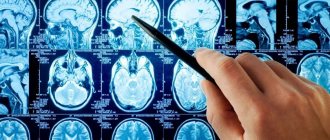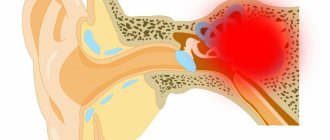Absolute contraindications
Anamnestic
- Serious head injury or stroke in the previous three months.
- Previous intracranial hemorrhage (hemorrhagic stroke, subarachnoid hemorrhage, traumatic hematoma).
- Intracranial neoplasm; arteriovenous malformation or cerebral aneurysm.
- Intracranial or intraspinal intervention in the last 6 months.
- Puncture of a noncompressible artery in the last 7 days.
Clinical
- Symptoms indicating subarachnoid hemorrhage.
- Persistent increase in blood pressure (systolic ≥185 mm Hg or diastolic ≥110 mm Hg).
- Blood glucose <2.8 mmol/l.
- Ongoing internal bleeding.
- Acute bleeding diathesis, including, but not limited to, conditions defined as "hematological".
Hematological
- Platelets <100 G/L*.
- Currently taking anticoagulants with INR >1.7 or PT (prothrombin time) >15 seconds*.
- Administration of heparin in the previous 48 hours in combination with an increase in aPTT*.
- Taking direct thrombin inhibitors or direct inhibitors of coagulation factor Xa in combination with signs of their anticoagulant effect according to laboratory tests such as APTT, INR, ECT, TV or an adequate assessment of Xa activity.
CT scan of the brain
- Signs of hemorrhage.
- Signs of involvement of multiple lobes of the brain, decreased X-ray density extending to >33 percent of the cerebral hemisphere.
Thrombolytic therapy for ischemic stroke: predictors of safety and effectiveness
Systemic thrombolytic therapy with recombinant tissue plasminogen activator alteplase is currently the most optimal method of reperfusion for ischemic stroke. The article discusses the main predictors of the effectiveness and safety of this method of therapy, as well as the possibility of its use in patients with vertebrobasilar stroke.
Introduction
Ischemic stroke is a medical and social problem due to its widespread prevalence and severity of consequences (high incidence of mortality and disability). Systemic thrombolytic therapy (SLT) using recombinant tissue plasminogen activator (rt-PA) alteplase is the most effective and safe method of reperfusion for ischemic stroke in the first 4.5 hours from the onset of ischemic stroke [1, 2].
The TLT procedure became possible thanks to the introduction of computed tomography into clinical practice, which makes it possible to diagnose the nature of the stroke [3]. It should be noted that individual reports of the administration of fibrinolytics to patients, such as streptokinase and urokinase, only on the basis of the clinical picture of ischemic stroke were noted earlier [4, 5]. However, studies (MAST-I, MAST-E, AST), in which streptokinase was used for thrombolysis, were stopped early due to the high incidence of symptomatic hemorrhagic transformations [6–8].
Alteplase: pharmacokinetics, safety and efficacy study
Alteplase is rapidly cleared from circulating plasma: the rate of the process is 380–570 ml/min [9]. The pharmacokinetics of alteplase have been studied in healthy volunteers, as well as in patients with myocardial infarction [10]. The initial half-life has been shown to be less than five minutes (similar to natural plasminogen activator). Two open-label, dose-finding drug safety studies established the optimal dose of the drug for the treatment of ischemic stroke [11, 12].
The NINDS study was the first multicenter, randomized, placebo-controlled trial to demonstrate the safety and effectiveness of systemic TLT using rt-PA in the first three hours from the onset of the disease [13]. The following randomized placebo-controlled studies, ECASS I and II [14, 15], assessed the safety and effectiveness of different doses of rt-PA (ECASS I - 1.1 mg/kg, ECASS II - 0.9 mg/kg) in the first six hours from onset of stroke development. The safety results of the ECASS I and II studies were comparable to those of the NINDS study. In terms of effectiveness, no significant differences were found between the main group and the placebo group.
The two parts of the ATLANTIS study (A and B) assessed the safety and effectiveness of rt-PA at a dose of 0.9 mg/kg for up to five hours from the onset of disease. There was no significant positive effect of rt-PA compared to placebo [16].
The ECASS III trial [17] demonstrated the safety and effectiveness of systemic thrombolysis within the first 4.5 hours after symptom onset. The results of the work served as a reason to revise European and American recommendations for the treatment of ischemic stroke. It has been proposed to increase the therapeutic window for systemic TLT to 4.5 hours [1, 2]. In the Russian Federation, corresponding changes to the instructions for the drug alteplase were made on May 25, 2011.
The largest study, IST III [18], assessed the safety and effectiveness of systemic rt-PA TLT for ischemic stroke in the first six hours after its onset. The results of the work were considered neutral, since the primary end point was not achieved - the predominance of individuals with good recovery of impaired functions according to the Oxford scale in the TLT group.
Thus, at present, a positive evidence base for alteplase has been obtained only in two large studies - NINDS and ECASS III.
Factors influencing the effectiveness and safety of TLT
Possible options for the course of a stroke and its outcomes during reperfusion therapy are regression of neurological deficit with successful recanalization and reperfusion, the absence of any changes (due to the lack of recanalization and/or the development of irreversible damage to the brain substance in the lesion), as well as clinical deterioration. The latter is manifested by the development of complications, primarily hemorrhagic, reocclusion or re-embolism, or an increase in cerebral edema in case of insignificant effect of TLT.
The safety and clinical effectiveness (or lack thereof) of reperfusion therapy for ischemic stroke is influenced by:
- time of initiation of therapy;
- the presence and size of a brain region with potentially reversible changes;
- features of systemic and local hemodynamics;
- hemostasis factors;
- sensitivity of the brain substance to ischemia;
- degree of damage to the blood-brain barrier.
The dependence of the effectiveness and safety of fibrinolytic therapy on the time of its initiation has been demonstrated in a number of large studies. A pooled analysis of the results of the NINDS, ECASS I and II, ATLANTIS studies (n = 2775) showed that the odds ratio (OR) for a favorable outcome of the disease when thrombolysis was started in the first 90 minutes of stroke was 2.81 (95% confidence interval (CI) 1.75–4.5), from 90 to 180 minutes – 1.55 (95% CI 1.12–2.15). When starting TLT in the period from 181 to 270 minutes, the OR for a favorable outcome was already 1.40 (95% CI 1.05–1.85), after 271–360 minutes – 1.15 (95% CI 0.90–1. 47) [19]. Thus, time is the most important condition for the effectiveness of TLT [20]. That is why all recommendations for the treatment of patients with stroke emphasize the need to reduce all delays in starting therapy [1, 2].
In addition to the time factor, when performing TLT it is important to take into account the age of the patients. According to the instructions for use of the drug alteplase and the recommendations of the European Stroke Organization, patients under 18 years of age should not undergo TLT, and patients over 80 years of age –
with extreme caution [1].
While global experience with the use of rt-PA in children and adolescents with ischemic stroke is limited (there are only a few cases) [21], thrombolysis in patients in the older age group (over 80 years of age) is a routine practice both in the USA and in a number of European countries [ 22, 23]. Most researchers agree that TLT in people over 80 years of age is not associated with an increase in complications, such as hemorrhagic transformation of the brain lesion, and, therefore, does not lead to an increase in mortality [22]. It should be noted that in this age group there are higher rates of mortality and disability than among patients under 80 years of age, since age is an independent factor in increasing the risk of death due to stroke [24].
F. Mateen et al. analyzed data from the Canadian TLT registry for patients aged 80 to 89 years and from 90 to 99 years [23]. Both age groups were characterized by a predominance of females (61% in the group of 80–89 year olds and 77% in the group of 90–99 year olds) and initially severe stroke (more than 15 points on the National Institutes of Health stroke scale). of Health Stroke Scale), in 52 and 58%, respectively). Both groups had similar rates of symptomatic hemorrhagic transformation (4 and 7%, respectively), three-month mortality (33 and 52%, respectively), and a good degree of recovery of impaired neurological functions (26 and 30%, respectively). Thus, thrombolysis in patients both aged 80 to 89 years and 90 to 99 years old is equally safe and effective.
Despite the findings on the safety of TLT in people over 80 years of age, a Cochrane systematic review (26 randomized controlled trials, 7152 patients with stroke) noted a lack of convincing evidence to raise the upper age limit for fibrinolytic therapy [25]. The reason is the small number of patients over 80 years of age (approximately 1%) included in the meta-analysis.
A number of studies have focused on the safety and effectiveness of TLT in young stroke patients (under 45 years of age) [26, 27]. Their results are of particular interest due to the different correlation of risk factors and pathogenetic variants of ischemic stroke in this age group.
A subgroup analysis of data from the SITS-MOST registry showed that young patients after TLT have a more favorable outcome with a low incidence of symptomatic hemorrhagic transformation [26]. In a study by J. Putaala et al. a better degree of recovery of impaired neurological functions was also demonstrated in people under 45 years of age (40 versus 22% in the group of patients over 45 years of age). However, the incidence of hemorrhagic transformation between groups did not differ significantly [27]. Therefore, TLT is effective and safe in all age groups. However, the older the patients, the higher the number of functionally unfavorable outcomes and deaths.
Hemorrhagic transformation of the brain lesion during ischemic stroke is a serious complication, especially when performing TLT. M. Pessin et al., based on computed tomography data, proposed to introduce differences between hemorrhagic infarction and parenchymal hematomas [28].
Studies using computed tomography and magnetic resonance imaging have revealed that hemorrhagic transformation of the petechial hemorrhage type occurs in 15–45% of patients [29], and with the formation of a symptomatic parenchymal hematoma - in 5% [30].
The NINDS study clearly articulated the differences between types of hemorrhagic transformation. Hemorrhagic infarction is an area of hypodensity with hyperdense point inclusions with unclear contours within the ischemic zone. Parenchymal hematomas are typical homogeneous hyperdense formations with clear contours with or without mass effect [31].
The ECASS research group made its own amendments to the classification of hemorrhagic transformation. It has been proposed to distinguish between hemorrhagic infarction of the first and second types, as well as parenchymal hematomas of the first and second types [32]. Hemorrhagic infarction is defined as petechial permeation of the area of ischemic injury without a mass effect. In the first type, small petechiae are observed in the ischemic zone; in the second type, confluent petechial hemorrhages are observed. Parenchymal hematomas are defined as hemorrhages with mass effect. In the first type, hematomas account for 30% of the ischemic volume with a significant mass effect. Hemorrhages remote from the focus of ischemic damage (multifocal or single) are included in a separate group. In the NINDS study, this complication was observed in 1.3% of patients. In the ECASS I and II studies, in 23 (3.7%) of 620 and 16 (2.0%) of 800 patients, respectively.
Any factors leading to increased permeability of the blood-brain barrier can cause hemorrhagic transformation during TLT. T. Neumann-Haefelin et al. assessed the influence of the severity of leukoaraiosis on the development of hemorrhagic transformation in patients with ischemic stroke during TLT [33]. Symptomatic intracranial hemorrhages were significantly more common in patients with leukoaraiosis - 2 or 3 points on the Fazekas scale (12 (10.5%) of 114 patients) than in patients with minor leukoaraiosis - 13 (3.8%) of 335 (OR 2.9 (95% CI 1.29–6.59), p = 0.015). Logistic regression analysis showed that leukoaraiosis is an independent prognostic factor for the development of systemic hemorrhagic transformation as a result of TLT in patients with ischemic stroke.
Signs of early ischemia on a CT scan of the brain (hypodense changes in the brain substance, loss of contrast between gray and white matter in the convexital cortex, signs of swelling of the brain substance - smoothing of the sulci and compression of the cerebral ventricles) were also associated with an increased risk of developing symptomatic intracranial hemorrhages during TLT [34, 35].
The volume of hypodense changes in the brain substance is the main risk factor for the development of symptomatic intracranial hemorrhages. To assess it, it is recommended to use a scale for assessing early signs of computed tomography of cerebral ischemia (Alberta Stroke Program Early CT Score - ASPECTS) [36]. It was found that a low ASPECTS score (
Features of TLT in patients with ischemic stroke in the vertebrobasilar system
Carrying out TLT in patients with ischemic stroke in the vertebrobasilar system has its differences due to the structural features of the brainstem and cerebellum, as well as their blood supply [38–40]. Despite the large number of described cases of reperfusion therapy for vascular lesions of the vertebrobasilar system, mainly the basilar artery, not a single large randomized study has been conducted to evaluate the safety and effectiveness of this therapy depending on the affected area.
Currently, the question remains open about the tactics of reperfusion therapy for damage to the basilar artery (systemic thrombolysis or endovascular interventions). The largest prospective study comparing different reperfusion regimens for basilar artery disease is BASICS [41]. The study evaluated three treatment options in different combinations: antiplatelet and anticoagulant, systemic and intra-arterial, thromboembolectomy and stenting. The number of participants was 592. For 402 (67%) patients, a poor outcome was recorded: 4–5 points on the Modified Rankin Scale or death. In patients with mild to moderate symptoms treated with antiplatelet drugs and anticoagulants, the risk of adverse outcome was comparable to that of patients receiving systemic TLT and intra-arterial therapy. While in patients with severe stroke, the risk of an unfavorable outcome was lower when using reperfusion therapy than when taking antiplatelet drugs and anticoagulants. However, no significant differences in outcomes were obtained between different options of reperfusion therapy.
Since there were no significant differences in outcomes during systemic and selective TLT in patients with basilar artery occlusion, the question of the advisability of increasing the time from the onset of stroke to therapy remains relevant.
The most optimal option in this case seems to be combined reperfusion therapy. This approach would allow treatment to begin in a shorter period of time and take advantage of both reperfusion methods. Intravenous thrombolysis, as the fastest and technically simplest method, can be carried out at the first stage of therapy in clinics that do not have an x-ray surgery service, with subsequent transportation of the patient to a specialized center for endovascular intervention if there is no effect from the first intravenous administration of thrombolytic.
Considering the availability of studies demonstrating the feasibility and safety of such a scheme (drip, ship, retrieve) in patients with ischemic stroke [39, 42], and the possibility of conducting reperfusion therapy in patients with vertebrobasilar stroke in a wider therapeutic window, such multi-stage therapy could become preferable for patients with such pathology.
T. Pfefferkorn et al. analyzed various schemes for transporting patients for reperfusion therapy for basilar artery occlusion [43, 44]. One scheme involved transportation from a primary stroke center to a specialized one for the purpose of further selective TLT. The second - to a specialized center after systemic TLT with rt-PA at a dose of 0.9 mg/kg. In a specialized center, after emergency computed tomography angiography was performed in case of persistent occlusion of the main artery, mechanical thromboembolectomy was performed using MERCI Retriever, AngioJet and Penumbra devices. In the intra-arterial thrombolysis group, the rate of basilar artery recanalization was 92% (24 of 26), in the group of intravenous TLT and mechanical thromboembolectomy - 85% (22 of 26). Moreover, in 38% of cases, recanalization was achieved after intravenous administration of rt-PA; further mechanical thromboembolectomy was not required. And in the case of ineffective systemic TLT, the main artery was recanalized using mechanical thromboembolectomy. The effectiveness of different mechanical thromboembolectomy devices for basilar artery occlusion did not differ. It is important to emphasize that significant differences were obtained between the groups in the functional outcome by the third month from the onset of the disease: 4.7 points on the modified Rankin scale in the group of intra-arterial TLT and 3.4 points when using systemic TLT followed by mechanical thromboembolectomy.
The combination of intravenous thrombolysis and thromboembolectomy has been shown in small studies to be the most promising reperfusion therapy regimen for basilar artery occlusion. It is possible that the use of third-generation fibrinolytics (recombinant prourokinase, tenecteplase) with a long half-life in the “intravenous thrombolysis - thromboembolectomy” scheme will simplify the first stage of reperfusion therapy to a single bolus administration of the drug without the need for further infusion, which will reduce the time before the start of intervention.
Conclusion
Carrying out TLT taking into account the clinical and pathogenetic features of the disease, the localization of the lesion, data from additional research methods (primarily neuroimaging), and identifying predictors of hemorrhagic complications will contribute to a higher safety and effectiveness of this method of treatment for ischemic stroke.









